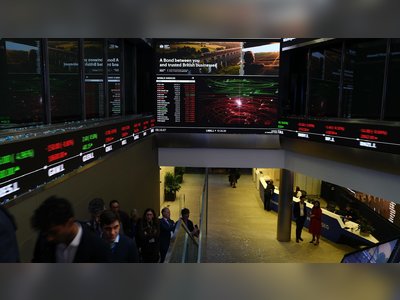
“Emily in Paris” and the Rise of Ambient TV
In its recent programming, Netflix is pioneering a genre of television that you don’t have to pay attention to in order to enjoy.
By the end of its second episode, I knew that Netflix’s new series “Emily in Paris” was not a lighthearted romantic travelogue but an artifact of contemporary dystopia. At that point, Emily had already gone jogging, and the multicolored wheels of her Apple-esque step-counter appeared on my television screen. The circles filled; Emily had pleased the robots monitoring her health.
During her next run, a small square popped up: a visualization of Emily’s Instagram account, to which she posted a photo of Paris, accruing onscreen likes. Later, Emily talked, via video call, with her old marketing-agency boss back in Chicago, whom she had replaced on the Paris sojourn when the boss found herself pregnant. My television displayed a closeup of Emily’s phone showing the boss’s face, inset with an image of Emily’s face—three layers of screens at once.
Emily is a millennial naïf, played by Lily Collins, who is meant to bring American-capitalist wisdom to a French agency that caters to luxury brands. The showrunner is Darren Star, the creator of “Sex and the City,” but if Carrie’s column lent that show a narrative structure and momentum—everything is copy—“Emily in Paris” begins and ends in an avalanche of desiccated digital-marketing language that seems to have subsumed Emily’s soul.
She cares about nothing more than “social,” impressions, R.O.I. Many episodes climax in the successful taking of a photo for Instagram. In the course of the season, fulfilling a prophecy cast by Collins’s dramatic eyebrows and wide eyes, our heroine becomes an Instagram influencer in her own right, those onscreen follower numbers jumping to ten, twenty thousand (not nearly enough to make her the kind of celebrity the show portrays, as viewers pointed out). Emily’s job is to get more likes for brands; her life is to get more likes for herself. Everything is content.
But all of that barely matters. The purpose of “Emily in Paris” is to provide sympathetic background for staring at your phone, refreshing your own feeds—on which you’ll find “Emily in Paris” memes, including a whole genre of TikTok remakes. It’s O.K. to look at your phone all the time, the show seems to say, because Emily does it, too.
The episodic plots are too thin to ever be confusing; when you glance back up at the television, chances are that you’ll find tracking shots of the Seine or cobblestoned alleyways, lovely but meaningless. If you want more drama, you can open Twitter, to augment the experience. Or just leave the show on while cleaning the inevitable domestic messes of quarantine. Eventually, sensing that you’ve played two episodes straight without pausing or skipping, Netflix will ask if you’re still really watching. Shamed, I clicked the Yes button, and Emily continued being in Paris.
In this and other recent programming, Netflix is pioneering a genre that I’ve come to think of as ambient television. It’s “as ignorable as it is interesting,” as the musician Brian Eno wrote, when he coined the term “ambient music” in the liner notes to his 1978 album “Ambient 1: Music for Airports,” a wash of slow melodic synth compositions. Ambient denotes something that you don’t have to pay attention to in order to enjoy but which is still seductive enough to be compelling if you choose to do so momentarily.
Like gentle New Age soundscapes, “Emily in Paris” is soothing, slow, and relatively monotonous, the dramatic moments too predetermined to really be dramatic. Nothing bad ever happens to our heroine for long. The earlier era of prestige TV was predicated on shows with meta-narratives to be puzzled out, and which merited deep analyses read the day after watching. Here, there is nothing to figure out; as prestige passes its peak, we’re moving into the ambient era, which succumbs to, rather than competes with, your phone.
“Emily in Paris” was just renewed for a second season; its formula of thin fictional storytelling wrapped in exotic backdrops was an instant success that seems destined to be reiterated many times over, in other locales, with other Emilies. But Netflix’s back catalogue of ambient options is made up of reality shows: “Dream Home Makeover” is ambient interior decorating; “Taco Chronicles,” ambient foodie travel; “Get Organized with the Home Edit,” ambient cleaning; “Street Food,” ambient cooking; “MeatEater,” ambient outdoorsmanship.
What these shows all have in common is their placidity—there’s little in the way of conflict or tension—and their reliance on B-roll, the footage that filmmakers intersperse with their main shots to smooth transitions between cuts. There often seems to be more B-roll than A, however. Viewers can select from footage of beef getting sliced, shelves being filled, or walks through foreign cities.
Like earlier eras of TV, ambient television is less a creative innovation than a product of the technological and social forces of our time. Beginning in the nineteen-thirties, soap operas, first on the radio and then on television, broadcast long-running daytime dramas in which the logic of subplots didn’t matter as much as consistency—the fact that they were produced quickly and cheaply and broadcast at the same time every day.
The name came from the soap brands that bought ads on the shows, to reach the audience of women at home, but it also evoked the banality of domestic labor that the programs distracted from, providing welcome background noise.
The advent of streaming, and cord-cutting, allowed viewers a more intentional relationship to TV, at least in theory. When Netflix and other platforms began dumping entire seasons of shows at once, binging became a byword for paying deep attention, as viewers gave themselves over to intricate drama or quirky comedy. But now we’re learning to stream as if we never abandoned cable in the first place, especially during quarantine, when nothing’s stopping you from leaving the TV on all day long.
As with soaps and chores, the current flow of ambient television provides a numbing backdrop to the rest of our digital consumption: feeds of fragmented text, imagery, and video algorithmically sorted to be as provocative as possible. Ambience offers the increasingly rare possibility of disengagement while still staring at a screen.
In the two-thousand-tens, there was a brief vogue for “slow TV,” reality television of unedited reality, such as a more than seven-hour real-time video of a train ride from Bergen to Oslo, shot in 2009, and a Norwegian production, in 2016, showing twelve hours of the extreme tidal current in the strait of Saltstraumen. The durational videos inspire introversion and reflection, like meditation: “Slow TV is high-definition in its visual information, yet it gets its meaning from viewers’ imaginative consciousness,” Nathan Heller wrote, in The New Yorker.
I recall the videos chiefly from parties at my artist friends’ house, where everyone would inevitably end up stoned on the couch, gasping as the train entered a tunnel and the screen blacked out. Slow TV inspires a kind of awe at realness, the texture of experience itself; it’s a phenomenological exercise that heightens our perception.
Ambient television, in contrast, aims to erase thought entirely, smoothing any disruptive texture or dissonance. Its high-resolution shots are chopped and composed into lulling montages—slow motion, fast motion, drone footage—that numb the senses with color and movement. It provides glossy, comforting oblivion, or, as Matisse once wrote, of his own paintings, “something like a good armchair.”
The 2015 début of Netflix’s “Chef’s Table,” in retrospect, may have paved the way for ambient streaming content. It mingled documentary-style interviews of and about chefs, whom it upheld as visionary artists, with salivating closeups of their dishes, on the model of “Jiro Dreams of Sushi.” (The show and the film were both created by David Gelb.)
After six seasons of “Chef’s Table,” Netflix has spun the show off into multiple, increasingly literal series that exemplify the tendencies of ambient TV. “Street Food” focusses on the casual cuisine of different regions, a mood board of inebriated snacking. “Taco Chronicles” eliminates the need for a human subject altogether, by offering narrations from the personified voice of the food itself: “Soy el taco de carnitas.”
Chef biography or historical education come second to the hindbrain visual pleasure of meat bouncing on a grill. The shows are functionally screen savers, never demanding your attention; they do draw it, but only as much as a tabletop bouquet of flowers. (Still, owing to such blatant subliminal messaging, I finished watching “Taco Chronicles” absolutely desperate for tacos.)
The passive engagement of ambient television is a boon for streaming services, which just want you to keep binging so that you feel your subscription is justified. I noticed the show “Dream Home Makeover” immediately when it débuted, on October 16th, because Netflix’s recommendation algorithm put it at the top of my account’s home page.
In February of this year, the streaming service launched a “Top 10” feature, which displays the ten most popular shows of the day in your country and tags the shows’ thumbnails with their rank—an effort to ameliorate the uncanny feeling, often inspired by algorithmic feeds, that no one else is seeing quite the same thing that you are.
The feature also makes surfing Netflix an even more passive experience: whatever other people are watching is probably good, or at least you’ll be able to discuss it with a friend later. (“Emily in Paris” made the top spot.) “Dream Home Makeover” immediately hit the charts; I clicked on it because it was there.
What followed was a plush haze of beige fabric, built-in open shelving, and brass fixtures, as Shea and Syd McGee, the co-founders of the Utah design firm Studio McGee, decorated vast minimalist mansions around their home base of Salt Lake City. Client projects are interspersed with vignettes of the McGees’s own under-construction home, which looks like a cavernous ski lodge crossed with a denuded Dutch church after the sixteenth-century Protestant Beeldenstorm.
Another couple the McGees work for, wealthy developers of tract housing, boast on camera that their new house is seventy-nine hundred square feet. Never has a television show featured so much blank, empty space—a mirror to the state of my mind as I watched it.
Shea, the principal designer, overlays each new room with the same palette of custom molding, faux mid-century furniture, gleaming countertops, and pendant lamps. Knowing exactly what to expect each time doesn’t dull the pleasure of the unveiling; the change is still more satisfyingly dramatic than the superficial closet rearrangements of “The Home Edit.” Yet even an authentic mid-century-modern house in Los Angeles gets the white-wall, beige-couch, marble-backsplash treatment in Episode 4, its history flattened into easy Instagram friendliness.
“Dream Home Makeover” is Netflix’s attempt to replicate the successful format of “Fixer Upper,” HGTV’s redecorating behemoth, which stars another husband-and-wife team with a signature style commodified by books and product lines. What distinguishes Netflix’s version is the sheer visual vacuum. Everything is white, including nearly all of the people.
Shea graduated from Brigham Young University, and she and Syd moved from California to Salt Lake City to establish their company and raise their two daughters. The first few episodes focus on other Utah couples who want the replica-McGee style. Many of them dress the same and have the same haircuts: military-short for the men, blond fusilli curls for the women. The clients often have a plenitude of bedrooms or bunks and boast of their large families. Mormonism is all but explicit, and yet the show, coasting along on its identikit makeovers, never acknowledges it.
The ambience of ambient TV is often predicated on homogeneity; any diversity or discordance would disrupt the smooth, lulling surface. (“Emily in Paris” almost entirely stars white actors, too.) The lurking subtext of “Dream Home Makeover,” a kind of soft-white capitalist nationalism cloaked in throw pillows, brought to mind for me the architect Rem Koolhaas’s essay “The Generic City,” from 1995.
In it, Koolhaas argues that globalization has caused a mass homogenization that leaves modern cities feeling like an airport, “a trance of almost unnoticeable aesthetic experiences.” He added that the “pervasive lack of urgency and insistence acts like a potent drug,” inducing “a hallucination of the normal.” In other words, the hypnotic quality of ambient content creates a false sense that whatever it presents is a neutral condition, a common denominator, though it is decidedly not.
There are other styles of décor in the world, even if “Dream Home Makeover” doesn’t depict them. For viewers of color, the show’s presumed neutrality was immediately discordant, as Twitter reactions demonstrated. What qualifies as soothingly ambient differs depending on the audience, and Netflix, with its onslaught of shows of a strange, unstated specificity, is trying to serve multiple varieties.
Another Netflix design production, “Styling Hollywood,” which débuted in August, 2019, stars the Black gay couple Jason Bolden and Adair Curtis, yet it hasn’t returned for a second season, and certainly didn’t gain the exposure—or perhaps the home-page recommendation support—that propelled “Dream Home Makeover” to meme status.
There’s a danger that, through algorithmic digital platforms, we can stay ensconced in our soothing aesthetic bubbles. When the season of “Dream Home Makeover” finishes on Netflix, it continues on Studio McGee’s Instagram account, where they’ve been posting clips that might as well be television outtakes, though they’re self-produced: more soft sofas, light fabrics, and blond children.
TV is social media and social media is TV—an ouroboros. The McGee ambient universe sprawls across platforms, perpetuating the hallucination of the normal. You never need to leave it, especially if your home is already designed to look like theirs.
Whereas the Internet once promised to provide on-demand access to limitless information and media to anyone willing to make use of a Google search, lately it has encouraged a more passive kind of engagement, a state of slack-jawed consumption only intensified by this past year’s quarantine ennui. Streaming companies once pitched themselves as innovators for offering the possibility to watch anything at any time, but do we really want to choose? The prevalence of ambient media suggests that we don’t. Netflix even recently announced that it is experimenting with its own version of a preprogrammed TV channel, called Direct.
Serving ambient experience is now a competition for digital platforms, as they attempt to further infiltrate our lives. During the past four years, TikTok has become the fastest-growing social-media platform ever, with an estimated eight hundred million users in 2020. What distinguishes TikTok is not its content nor its format of minute-long clips—it’s usually some variation of “America’s Funniest Home Videos”—but the nature of its feed.
TikTok’s For You tab serves an endless stream of short videos that algorithmically adapt to your interests, sorting the content most likely to engage you. Using it feels like having your mind read, because all you do is watch or skip, focus or ignore, a decision made too fast to be fully conscious. Individual videos or accounts matter less than categories or memes; at the moment, my feed is mostly clips of skateboarding, cooking, and carpentry, not unlike the mundanity of the Netflix shows but also accelerated into media gavage. TikTok is an app for ambience.
More universal right now than “Emily in Paris,” or any streaming show, is a single TikTok user, 420doggface208, also known as Nathan Apodaca, a thirty-seven-year-old Idahoan of Native American and Mexican descent. Apodaca posted a selfie video taken while skateboarding down a highway, under a blue sky settling into sunset.
He lip-synchs to Fleetwood Mac’s hit “Dreams,” from 1977, and swigs from a large plastic container of Ocean Spray cran-raspberry juice. The video’s elements don’t logically cohere or relate; they just collide, like random S.E.O. terms. Yet Apodaca’s clip has more than seventy million views, and drove “Dreams” onto the Billboard streaming Top Ten. It’s more atmosphere than content, the motion, the music, and the backdrop coalescing into a single moment of bittersweet freedom that loops over and over again.
During her next run, a small square popped up: a visualization of Emily’s Instagram account, to which she posted a photo of Paris, accruing onscreen likes. Later, Emily talked, via video call, with her old marketing-agency boss back in Chicago, whom she had replaced on the Paris sojourn when the boss found herself pregnant. My television displayed a closeup of Emily’s phone showing the boss’s face, inset with an image of Emily’s face—three layers of screens at once.
Emily is a millennial naïf, played by Lily Collins, who is meant to bring American-capitalist wisdom to a French agency that caters to luxury brands. The showrunner is Darren Star, the creator of “Sex and the City,” but if Carrie’s column lent that show a narrative structure and momentum—everything is copy—“Emily in Paris” begins and ends in an avalanche of desiccated digital-marketing language that seems to have subsumed Emily’s soul.
She cares about nothing more than “social,” impressions, R.O.I. Many episodes climax in the successful taking of a photo for Instagram. In the course of the season, fulfilling a prophecy cast by Collins’s dramatic eyebrows and wide eyes, our heroine becomes an Instagram influencer in her own right, those onscreen follower numbers jumping to ten, twenty thousand (not nearly enough to make her the kind of celebrity the show portrays, as viewers pointed out). Emily’s job is to get more likes for brands; her life is to get more likes for herself. Everything is content.
But all of that barely matters. The purpose of “Emily in Paris” is to provide sympathetic background for staring at your phone, refreshing your own feeds—on which you’ll find “Emily in Paris” memes, including a whole genre of TikTok remakes. It’s O.K. to look at your phone all the time, the show seems to say, because Emily does it, too.
The episodic plots are too thin to ever be confusing; when you glance back up at the television, chances are that you’ll find tracking shots of the Seine or cobblestoned alleyways, lovely but meaningless. If you want more drama, you can open Twitter, to augment the experience. Or just leave the show on while cleaning the inevitable domestic messes of quarantine. Eventually, sensing that you’ve played two episodes straight without pausing or skipping, Netflix will ask if you’re still really watching. Shamed, I clicked the Yes button, and Emily continued being in Paris.
In this and other recent programming, Netflix is pioneering a genre that I’ve come to think of as ambient television. It’s “as ignorable as it is interesting,” as the musician Brian Eno wrote, when he coined the term “ambient music” in the liner notes to his 1978 album “Ambient 1: Music for Airports,” a wash of slow melodic synth compositions. Ambient denotes something that you don’t have to pay attention to in order to enjoy but which is still seductive enough to be compelling if you choose to do so momentarily.
Like gentle New Age soundscapes, “Emily in Paris” is soothing, slow, and relatively monotonous, the dramatic moments too predetermined to really be dramatic. Nothing bad ever happens to our heroine for long. The earlier era of prestige TV was predicated on shows with meta-narratives to be puzzled out, and which merited deep analyses read the day after watching. Here, there is nothing to figure out; as prestige passes its peak, we’re moving into the ambient era, which succumbs to, rather than competes with, your phone.
“Emily in Paris” was just renewed for a second season; its formula of thin fictional storytelling wrapped in exotic backdrops was an instant success that seems destined to be reiterated many times over, in other locales, with other Emilies. But Netflix’s back catalogue of ambient options is made up of reality shows: “Dream Home Makeover” is ambient interior decorating; “Taco Chronicles,” ambient foodie travel; “Get Organized with the Home Edit,” ambient cleaning; “Street Food,” ambient cooking; “MeatEater,” ambient outdoorsmanship.
What these shows all have in common is their placidity—there’s little in the way of conflict or tension—and their reliance on B-roll, the footage that filmmakers intersperse with their main shots to smooth transitions between cuts. There often seems to be more B-roll than A, however. Viewers can select from footage of beef getting sliced, shelves being filled, or walks through foreign cities.
Like earlier eras of TV, ambient television is less a creative innovation than a product of the technological and social forces of our time. Beginning in the nineteen-thirties, soap operas, first on the radio and then on television, broadcast long-running daytime dramas in which the logic of subplots didn’t matter as much as consistency—the fact that they were produced quickly and cheaply and broadcast at the same time every day.
The name came from the soap brands that bought ads on the shows, to reach the audience of women at home, but it also evoked the banality of domestic labor that the programs distracted from, providing welcome background noise.
The advent of streaming, and cord-cutting, allowed viewers a more intentional relationship to TV, at least in theory. When Netflix and other platforms began dumping entire seasons of shows at once, binging became a byword for paying deep attention, as viewers gave themselves over to intricate drama or quirky comedy. But now we’re learning to stream as if we never abandoned cable in the first place, especially during quarantine, when nothing’s stopping you from leaving the TV on all day long.
As with soaps and chores, the current flow of ambient television provides a numbing backdrop to the rest of our digital consumption: feeds of fragmented text, imagery, and video algorithmically sorted to be as provocative as possible. Ambience offers the increasingly rare possibility of disengagement while still staring at a screen.
In the two-thousand-tens, there was a brief vogue for “slow TV,” reality television of unedited reality, such as a more than seven-hour real-time video of a train ride from Bergen to Oslo, shot in 2009, and a Norwegian production, in 2016, showing twelve hours of the extreme tidal current in the strait of Saltstraumen. The durational videos inspire introversion and reflection, like meditation: “Slow TV is high-definition in its visual information, yet it gets its meaning from viewers’ imaginative consciousness,” Nathan Heller wrote, in The New Yorker.
I recall the videos chiefly from parties at my artist friends’ house, where everyone would inevitably end up stoned on the couch, gasping as the train entered a tunnel and the screen blacked out. Slow TV inspires a kind of awe at realness, the texture of experience itself; it’s a phenomenological exercise that heightens our perception.
Ambient television, in contrast, aims to erase thought entirely, smoothing any disruptive texture or dissonance. Its high-resolution shots are chopped and composed into lulling montages—slow motion, fast motion, drone footage—that numb the senses with color and movement. It provides glossy, comforting oblivion, or, as Matisse once wrote, of his own paintings, “something like a good armchair.”
The 2015 début of Netflix’s “Chef’s Table,” in retrospect, may have paved the way for ambient streaming content. It mingled documentary-style interviews of and about chefs, whom it upheld as visionary artists, with salivating closeups of their dishes, on the model of “Jiro Dreams of Sushi.” (The show and the film were both created by David Gelb.)
After six seasons of “Chef’s Table,” Netflix has spun the show off into multiple, increasingly literal series that exemplify the tendencies of ambient TV. “Street Food” focusses on the casual cuisine of different regions, a mood board of inebriated snacking. “Taco Chronicles” eliminates the need for a human subject altogether, by offering narrations from the personified voice of the food itself: “Soy el taco de carnitas.”
Chef biography or historical education come second to the hindbrain visual pleasure of meat bouncing on a grill. The shows are functionally screen savers, never demanding your attention; they do draw it, but only as much as a tabletop bouquet of flowers. (Still, owing to such blatant subliminal messaging, I finished watching “Taco Chronicles” absolutely desperate for tacos.)
The passive engagement of ambient television is a boon for streaming services, which just want you to keep binging so that you feel your subscription is justified. I noticed the show “Dream Home Makeover” immediately when it débuted, on October 16th, because Netflix’s recommendation algorithm put it at the top of my account’s home page.
In February of this year, the streaming service launched a “Top 10” feature, which displays the ten most popular shows of the day in your country and tags the shows’ thumbnails with their rank—an effort to ameliorate the uncanny feeling, often inspired by algorithmic feeds, that no one else is seeing quite the same thing that you are.
The feature also makes surfing Netflix an even more passive experience: whatever other people are watching is probably good, or at least you’ll be able to discuss it with a friend later. (“Emily in Paris” made the top spot.) “Dream Home Makeover” immediately hit the charts; I clicked on it because it was there.
What followed was a plush haze of beige fabric, built-in open shelving, and brass fixtures, as Shea and Syd McGee, the co-founders of the Utah design firm Studio McGee, decorated vast minimalist mansions around their home base of Salt Lake City. Client projects are interspersed with vignettes of the McGees’s own under-construction home, which looks like a cavernous ski lodge crossed with a denuded Dutch church after the sixteenth-century Protestant Beeldenstorm.
Another couple the McGees work for, wealthy developers of tract housing, boast on camera that their new house is seventy-nine hundred square feet. Never has a television show featured so much blank, empty space—a mirror to the state of my mind as I watched it.
Shea, the principal designer, overlays each new room with the same palette of custom molding, faux mid-century furniture, gleaming countertops, and pendant lamps. Knowing exactly what to expect each time doesn’t dull the pleasure of the unveiling; the change is still more satisfyingly dramatic than the superficial closet rearrangements of “The Home Edit.” Yet even an authentic mid-century-modern house in Los Angeles gets the white-wall, beige-couch, marble-backsplash treatment in Episode 4, its history flattened into easy Instagram friendliness.
“Dream Home Makeover” is Netflix’s attempt to replicate the successful format of “Fixer Upper,” HGTV’s redecorating behemoth, which stars another husband-and-wife team with a signature style commodified by books and product lines. What distinguishes Netflix’s version is the sheer visual vacuum. Everything is white, including nearly all of the people.
Shea graduated from Brigham Young University, and she and Syd moved from California to Salt Lake City to establish their company and raise their two daughters. The first few episodes focus on other Utah couples who want the replica-McGee style. Many of them dress the same and have the same haircuts: military-short for the men, blond fusilli curls for the women. The clients often have a plenitude of bedrooms or bunks and boast of their large families. Mormonism is all but explicit, and yet the show, coasting along on its identikit makeovers, never acknowledges it.
The ambience of ambient TV is often predicated on homogeneity; any diversity or discordance would disrupt the smooth, lulling surface. (“Emily in Paris” almost entirely stars white actors, too.) The lurking subtext of “Dream Home Makeover,” a kind of soft-white capitalist nationalism cloaked in throw pillows, brought to mind for me the architect Rem Koolhaas’s essay “The Generic City,” from 1995.
In it, Koolhaas argues that globalization has caused a mass homogenization that leaves modern cities feeling like an airport, “a trance of almost unnoticeable aesthetic experiences.” He added that the “pervasive lack of urgency and insistence acts like a potent drug,” inducing “a hallucination of the normal.” In other words, the hypnotic quality of ambient content creates a false sense that whatever it presents is a neutral condition, a common denominator, though it is decidedly not.
There are other styles of décor in the world, even if “Dream Home Makeover” doesn’t depict them. For viewers of color, the show’s presumed neutrality was immediately discordant, as Twitter reactions demonstrated. What qualifies as soothingly ambient differs depending on the audience, and Netflix, with its onslaught of shows of a strange, unstated specificity, is trying to serve multiple varieties.
Another Netflix design production, “Styling Hollywood,” which débuted in August, 2019, stars the Black gay couple Jason Bolden and Adair Curtis, yet it hasn’t returned for a second season, and certainly didn’t gain the exposure—or perhaps the home-page recommendation support—that propelled “Dream Home Makeover” to meme status.
There’s a danger that, through algorithmic digital platforms, we can stay ensconced in our soothing aesthetic bubbles. When the season of “Dream Home Makeover” finishes on Netflix, it continues on Studio McGee’s Instagram account, where they’ve been posting clips that might as well be television outtakes, though they’re self-produced: more soft sofas, light fabrics, and blond children.
TV is social media and social media is TV—an ouroboros. The McGee ambient universe sprawls across platforms, perpetuating the hallucination of the normal. You never need to leave it, especially if your home is already designed to look like theirs.
Whereas the Internet once promised to provide on-demand access to limitless information and media to anyone willing to make use of a Google search, lately it has encouraged a more passive kind of engagement, a state of slack-jawed consumption only intensified by this past year’s quarantine ennui. Streaming companies once pitched themselves as innovators for offering the possibility to watch anything at any time, but do we really want to choose? The prevalence of ambient media suggests that we don’t. Netflix even recently announced that it is experimenting with its own version of a preprogrammed TV channel, called Direct.
Serving ambient experience is now a competition for digital platforms, as they attempt to further infiltrate our lives. During the past four years, TikTok has become the fastest-growing social-media platform ever, with an estimated eight hundred million users in 2020. What distinguishes TikTok is not its content nor its format of minute-long clips—it’s usually some variation of “America’s Funniest Home Videos”—but the nature of its feed.
TikTok’s For You tab serves an endless stream of short videos that algorithmically adapt to your interests, sorting the content most likely to engage you. Using it feels like having your mind read, because all you do is watch or skip, focus or ignore, a decision made too fast to be fully conscious. Individual videos or accounts matter less than categories or memes; at the moment, my feed is mostly clips of skateboarding, cooking, and carpentry, not unlike the mundanity of the Netflix shows but also accelerated into media gavage. TikTok is an app for ambience.
More universal right now than “Emily in Paris,” or any streaming show, is a single TikTok user, 420doggface208, also known as Nathan Apodaca, a thirty-seven-year-old Idahoan of Native American and Mexican descent. Apodaca posted a selfie video taken while skateboarding down a highway, under a blue sky settling into sunset.
He lip-synchs to Fleetwood Mac’s hit “Dreams,” from 1977, and swigs from a large plastic container of Ocean Spray cran-raspberry juice. The video’s elements don’t logically cohere or relate; they just collide, like random S.E.O. terms. Yet Apodaca’s clip has more than seventy million views, and drove “Dreams” onto the Billboard streaming Top Ten. It’s more atmosphere than content, the motion, the music, and the backdrop coalescing into a single moment of bittersweet freedom that loops over and over again.











